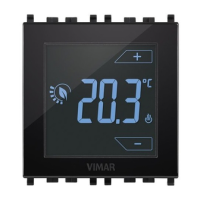18
• remote activation: the multi-function input (when enabled) automatically sets the “Tcomfort” tem-
perature as the setpoint.
In this context, the user can only change the temperature within a narrow range (see: 8.4.5) and cannot
carry out any further operations on the device; with the multi-function input disabled, the default mode
is "Antifreeze" (or OFF if on air-conditioning) and the user can manage the thermostat completely.
• remote reduction: the multi-function input (when enabled) forces a reduction in temperature (which
can be set via the submenu associated with that selection) with respect to “Tcomfort”.
In this context, the user can change the temperature within a narrow range (see par. 7.4.5) and cannot
carry out any other operations on the thermostat; with the multi-function input disabled, the thermostat
returns to the previously set operating mode and the user can manage the thermostat completely.
• (summer/winter switching): the multi-function input automatically switches the thermostat onto
air-conditioning mode (when on) or heating mode (when off).
On enabling this selection, the submenu described in 7.3 is no longer displayed.
This option is useful for centralized systems in which the air-conditioning or heating mode is performed
at the level of the entire building and impacts on many sub-environments.
Tap to confirm your choice.
7.8 OnOff/PID setting
This menu lets you select the way in which the ambient temperature will be controlled.
Via and you can select the following options:
• (OnOff control): this is the traditional "threshold" control so that, on exceeding the set tempera-
ture increased by (vice versa for air-conditioning), the heating is switched off to then be turned back
on when the room temperature drops below the set temperature.
The value can be set directly via the submenu that follows this selection.
• (P.I.D. control): this is an evolved algorithm that is able to keep the temperature in the environ-
ment more stable, increasing comfort; this algorithm switches the system on and off appropriately so
there will be a gradual increase or decrease in the thermal (or refrigerating) power of the system itself.
To take full advantage of its performance it needs to be suitably calibrated according to the type of
environment and heating system; in the light of this, the following parameters must be set via the sub-
menus that follow this selection:
• (temperature of proportional band): starting from the set temperature, Tb is the temperature range
in which the heating power goes from 0% to 100%.
For example: with the temperature (for heating) set to 20.0°C and Tb=4.0°C, the thermostat activates
the heating system on 100% when T.ambient is <= 16.0°C; as this temperature increases, the system
power is consequently lowered down to 0% when the ambient temperature reaches 20°C.
The value of Tb must be set consistently with the thermal capacity of the system; in general, it is rec-
ommended to use small values of Tb for environments with a good level of thermal insulation and vice
versa.
• (system cycle time): this is the time in which a cycle of regulation is completed; the shorter this time,
the better the regulation but the temperature control system is under greater stress.
This parameter setting is thus the result of a compromise between the accuracy of the regulator and

